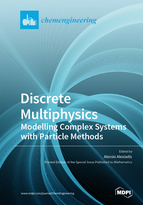Discrete Multiphysics: Modelling Complex Systems with Particle Methods
A special issue of ChemEngineering (ISSN 2305-7084).
Deadline for manuscript submissions: closed (30 June 2021) | Viewed by 41376
Special Issue Editor
Interests: mathematical modelling; computer simulations; particle methods; molecular dynamics; discrete multiphysics; coupling first-principle modelling with artificial intelligence; deep multiphysics
Special Issues, Collections and Topics in MDPI journals
Special Issue Information
Dear Colleagues,
I am pleased to invite you to participate in this Special Issue on “Discrete Multiphysics: Modelling Complex Systems with Particle Methods”.
Particle methods have proven their versatility and effectiveness in a variety of applications, ranging from modelling of molecules to the simulation of galaxies. Their power is even amplified when they are coupled together within a discrete multiphysics framework. Moreover, particle methods also couple extremely well (better than mesh-based algorithms) with artificial neural networka, as recent studies on deep multiphysics show.
In this Special Issue, we would very much appreciate contributions that show the power of particle methods in addressing multiphysics problems (including multiphase and complex flows). We specifically target methods such as smoothed particle hydrodynamics (SPH), the lattice spring model (LSM), peridynamics (PD) and the discrete element method (DEM) but other ‘members of the family’ such as Brownian dynamics (BD), dissipative particle dynamics (DPD), and molecular dynamics (MD) are welcome as well.
One of the reasons for looking at particle methods as members of the same family is that they all follow a very similar algorithm. This circumstance carries two consequences: (i) It is straightforward to couple particle methods together, and (ii) it is relatively easy to learn a new particle method if you are already familiar with another one. Therefore, in this Special Issue, emphasis will be given also to (i) contributions that explore the potential of coupling together different particle methods, and (ii) material useful to researchers familiar with a specific particle method who wish to expand their horizons to new ones. Consideration will be also given to contributions that share the ‘tricks of the trade’ of particle methods: i.e., good practice rules that researchers with years of experience have developed and which normally cannot be found in the open literature.
Dr. Alessio Alexiadis
Guest Editor
Manuscript Submission Information
Manuscripts should be submitted online at www.mdpi.com by registering and logging in to this website. Once you are registered, click here to go to the submission form. Manuscripts can be submitted until the deadline. All submissions that pass pre-check are peer-reviewed. Accepted papers will be published continuously in the journal (as soon as accepted) and will be listed together on the special issue website. Research articles, review articles as well as short communications are invited. For planned papers, a title and short abstract (about 100 words) can be sent to the Editorial Office for announcement on this website.
Submitted manuscripts should not have been published previously, nor be under consideration for publication elsewhere (except conference proceedings papers). All manuscripts are thoroughly refereed through a single-blind peer-review process. A guide for authors and other relevant information for submission of manuscripts is available on the Instructions for Authors page. ChemEngineering is an international peer-reviewed open access semimonthly journal published by MDPI.
Please visit the Instructions for Authors page before submitting a manuscript. The Article Processing Charge (APC) for publication in this open access journal is 1600 CHF (Swiss Francs). Submitted papers should be well formatted and use good English. Authors may use MDPI's English editing service prior to publication or during author revisions.
Keywords
- particle-based algorithms
- mesh-free models
- multiphysics
- smoothed particle hydrodynamics
- lattice spring model
- peridynamics
- discrete element method
- complex flows
- multiphase flows
- granular flows
- solid mechanics
- modelling breakage
- fluid-structure interactions
- modelling viscoelastic materials
- modelling plastic materials






